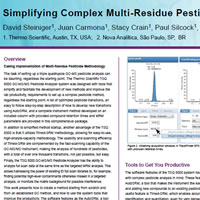
Simplifying Complex Multi-Residue Pesticide Methodology in GC-MS/MS Authors: David Steiniger1, Juan Carmona1, Stacy Crain1, Paul Silcock1, Jason Cole1, Grazielle Anaia2 Email para contato (felipe.lugao@novanalitica.com.br) 1Thermo Fisher Scientific, Austin, TX, USA; 2Nova Analítica, São Paulo, SP, BR |
Resumo do Pôster:The task of setting up a triple quadrupole GC-MS pesticide analysis can be daunting, regardless the starting point. If a small set of pesticides should be expanded to a larger set of pesticides to be analyzed or if a large pesticide set is analyzed in multiple runs on a single quadrupole and has to be combined into a single MRM analysis, tools that simplify and facilitate the development of the new method and improve the lab productivity are necessary. In addition to simplified method startup, another advantage of this Pesticide Analyzer system is that it utilizes Timed-SRM methodology, allowing for easy-to-use, high-analyte-capacity methodology. The usability and scanning efficiency of Timed-SRM are complemented by the fast-scanning capability of the GC-MS/MS instrument, making the analysis of hundreds of pesticides, with a total of over one thousand transitions, not just possible, but easy. This work presents how to create a method starting from scratch and from an established GC method, and how to use the system tools that improve the productivity. The software features as the AutoSRM, a tool that makes the instrument the easiest for developing and adding new compounds to an existing pesticide method, and Timed-SRM, which enables accurate pesticide identification and quantitation, even for very dense pesticide methodologies, are included in this work. The ability to do Timed-SRM significantly increases low-level sensitivity through a more efficient SRM scheduling. Also, the full scan/MRM capability of this new triple-quadrupole mass spectrometer combines the elite quantitation capabilities of MRM analysis with classic general unknown identification through full scan quadrupole library searching. Finally, the ability of the instrument to perform simultaneous full scan/MRM provides the capability to identify general unknowns in conjunction with target pesticides, filling a classic gap in targeted MRM analysis. |
